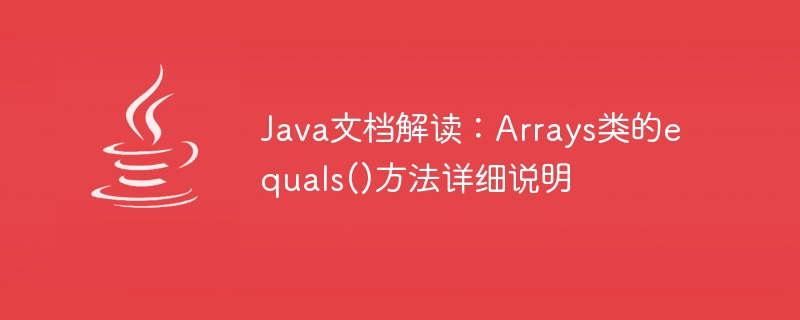

Interpretation of Java documentation: Detailed description of the equals() method of the Arrays class
In Java, the Arrays class is a static method that provides a series of methods for operating arrays Utility class. One of them is the equals() method. This article will explain the equals() method of the Arrays class in detail and provide specific code examples.
The equals() method of the Arrays class is used to compare whether two arrays are equal. This method has the following signature:
public static boolean equals(datatype[] a, datatype[] b)
where datatype represents the data type stored in the array. This method compares the elements in the two arrays to see if they are equal, and returns a Boolean value indicating whether they are equal. If the lengths and values of each element of the two arrays are equal, the equals() method returns true; otherwise, it returns false.
The following is a specific usage example:
import java.util.Arrays; public class ArrayComparison { public static void main(String[] args) { int[] array1 = {1, 2, 3, 4, 5}; int[] array2 = {1, 2, 3, 4, 5}; int[] array3 = {1, 2, 3, 4, 6}; System.out.println(Arrays.equals(array1, array2)); // 输出 true System.out.println(Arrays.equals(array1, array3)); // 输出 false } }
In the above example, we defined three arrays array1, array2 and array3. Among them, the elements of array1 and array2 are exactly the same, but the last element of array3 is different. Then we call the Arrays.equals() method respectively to compare these arrays. The results output true and false, indicating that the equals() method can correctly compare whether the elements of the two arrays are equal.
It should be noted that the equals() method is not suitable for multi-dimensional arrays. If you need to compare multi-dimensional arrays for equality, you can use the Arrays.deepEquals() method.
The following is a specific usage example:
import java.util.Arrays; public class MultiDimensionalArrayComparison { public static void main(String[] args) { int[][] array1 = {{1, 2}, {3, 4}}; int[][] array2 = {{1, 2}, {3, 4}}; int[][] array3 = {{1, 2}, {3, 5}}; System.out.println(Arrays.deepEquals(array1, array2)); // 输出 true System.out.println(Arrays.deepEquals(array1, array3)); // 输出 false } }
In the above example, we defined three two-dimensional arrays array1, array2 and array3. Call the Arrays.deepEquals() method individually to compare these arrays. The results output true and false, indicating that the deepEquals() method can correctly compare whether the elements of multi-dimensional arrays are equal.
Summary:
Java's Arrays class provides the equals() method for comparing whether two arrays are equal. This method compares the lengths of two arrays and the values of each element to see if they are equal in one-to-one correspondence. It should be noted that the equals() method is not applicable to multi-dimensional arrays. You can use the deepEquals() method to compare the equality of multi-dimensional arrays. By using these methods, you can easily compare the contents of arrays.
The above is the Java documentation interpretation: detailed description and code examples of the equals() method of the Arrays class. I hope it will be helpful to readers in understanding and using the equals() method.
The above is the detailed content of Interpretation of Java documentation: Detailed description of the equals() method of the Arrays class. For more information, please follow other related articles on the PHP Chinese website!
 modify ip
modify ip How to adjust the text size in text messages
How to adjust the text size in text messages Introduction to Java special effects implementation methods
Introduction to Java special effects implementation methods The difference between typedef and define
The difference between typedef and define How to unlock the password lock on your Apple phone if you forget it
How to unlock the password lock on your Apple phone if you forget it Ranking of the top ten digital currency exchanges
Ranking of the top ten digital currency exchanges windows lock screen shortcut keys
windows lock screen shortcut keys Comparative analysis of iqooneo8 and iqooneo9
Comparative analysis of iqooneo8 and iqooneo9



